华中农大成功克隆水稻不育基因
- 格式:pdf
- 大小:296.27 KB
- 文档页数:1
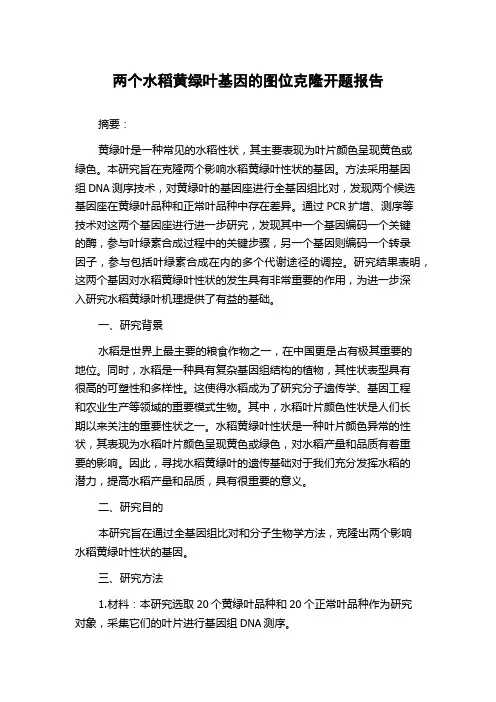
两个水稻黄绿叶基因的图位克隆开题报告摘要:黄绿叶是一种常见的水稻性状,其主要表现为叶片颜色呈现黄色或绿色。
本研究旨在克隆两个影响水稻黄绿叶性状的基因。
方法采用基因组DNA测序技术,对黄绿叶的基因座进行全基因组比对,发现两个候选基因座在黄绿叶品种和正常叶品种中存在差异。
通过PCR扩增、测序等技术对这两个基因座进行进一步研究,发现其中一个基因编码一个关键的酶,参与叶绿素合成过程中的关键步骤,另一个基因则编码一个转录因子,参与包括叶绿素合成在内的多个代谢途径的调控。
研究结果表明,这两个基因对水稻黄绿叶性状的发生具有非常重要的作用,为进一步深入研究水稻黄绿叶机理提供了有益的基础。
一、研究背景水稻是世界上最主要的粮食作物之一,在中国更是占有极其重要的地位。
同时,水稻是一种具有复杂基因组结构的植物,其性状表型具有很高的可塑性和多样性。
这使得水稻成为了研究分子遗传学、基因工程和农业生产等领域的重要模式生物。
其中,水稻叶片颜色性状是人们长期以来关注的重要性状之一。
水稻黄绿叶性状是一种叶片颜色异常的性状,其表现为水稻叶片颜色呈现黄色或绿色,对水稻产量和品质有着重要的影响。
因此,寻找水稻黄绿叶的遗传基础对于我们充分发挥水稻的潜力,提高水稻产量和品质,具有很重要的意义。
二、研究目的本研究旨在通过全基因组比对和分子生物学方法,克隆出两个影响水稻黄绿叶性状的基因。
三、研究方法1.材料:本研究选取20个黄绿叶品种和20个正常叶品种作为研究对象,采集它们的叶片进行基因组DNA测序。
2.全基因组比对:将黄绿叶品种和正常叶品种的基因组DNA序列进行比对,找出基因座间的差异。
3.PCR扩增:根据比对结果,设计基因座特异引物,对两个基因座进行PCR扩增。
4.克隆基因:将PCR扩增得到的产物进行回收、克隆和测序,验证它们是否是与黄绿叶性状有关的基因。
四、预期结果和意义通过本研究,我们预期可以克隆出两个影响水稻黄绿叶性状的基因,并进行基因功能分析、表达调控分析等,以期揭示水稻黄绿叶的分子遗传机制,对于解决水稻黄绿叶问题、提高水稻产量和品质都有着重要的意义。
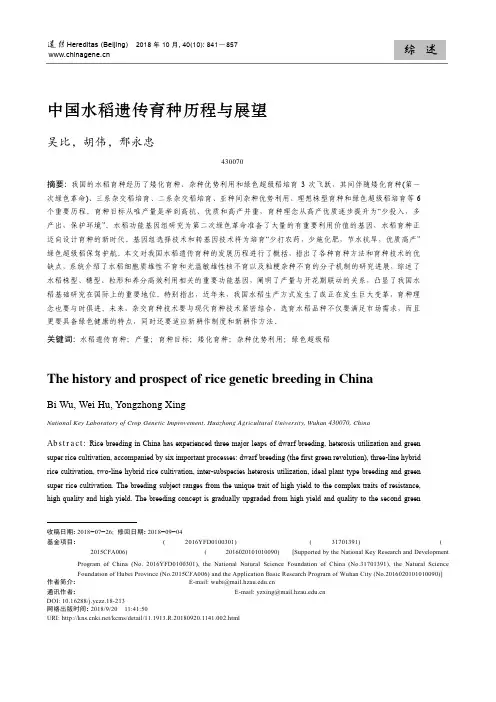
Hereditas (Beijing)2018年10月, 40(10): 841―857 收稿日期: 2018-07-26; 修回日期: 2018-09-04基金项目:科技部“七大作物育种”专项(编号:2016YFD0100301),国家自然科学基金项目(编号:31701391),湖北省自然科学基金项目(编号:2015CFA006)和武汉市应用基础研究项目(编号:2016020101010090)资助[Supported by the National Key Research and Development Program of China (No. 2016YFD0100301), the National Natural Science Foundation of China (No.31701391), the Natural ScienceFoundation of Hubei Province (No.2015CFA006) and the Application Basic Research Program of Wuhan City (No.2016020101010090)]作者简介: 吴比,博士,研究方向:水稻遗传学。
E-mail: wubi@通讯作者:邢永忠,教授,博士生导师,研究方向:水稻遗传学。
E-mail: yzxing@DOI: 10.16288/j.yczz.18-213网络出版时间: 2018/9/20 11:41:50URI: /kcms/detail/11.1913.R.20180920.1141.002.html综 述中国水稻遗传育种历程与展望吴比,胡伟,邢永忠华中农业大学,作物遗传改良国家重点实验室,武汉 430070摘要: 我国的水稻育种经历了矮化育种、杂种优势利用和绿色超级稻培育3次飞跃,其间伴随矮化育种(第一次绿色革命)、三系杂交稻培育、二系杂交稻培育、亚种间杂种优势利用、理想株型育种和绿色超级稻培育等6个重要历程。
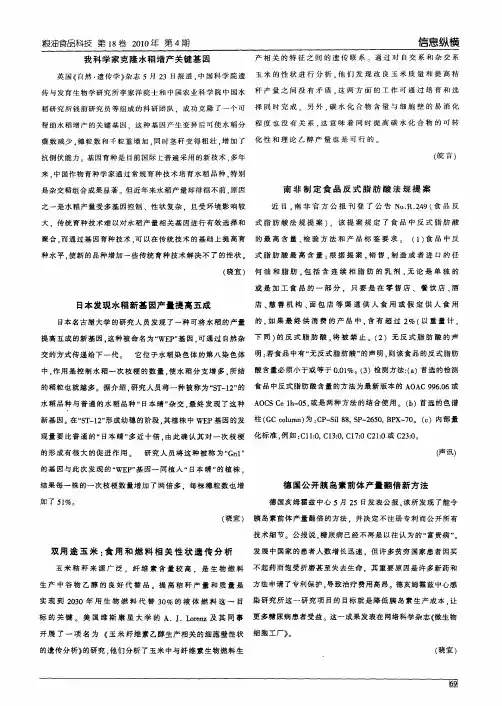
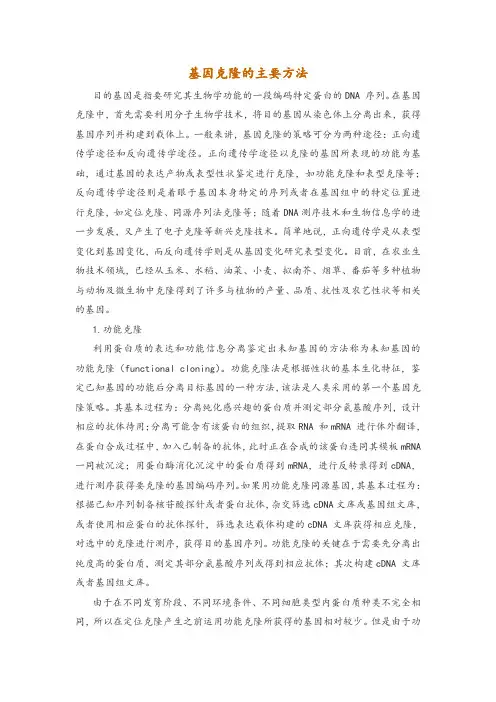
基因克隆的主要方法目的基因是指要研究其生物学功能的一段编码特定蛋白的DNA 序列。
在基因克隆中,首先需要利用分子生物学技术,将目的基因从染色体上分离出来,获得基因序列并构建到载体上。
一般来讲,基因克隆的策略可分为两种途径:正向遗传学途径和反向遗传学途径。
正向遗传学途径以克隆的基因所表现的功能为基础,通过基因的表达产物或表型性状鉴定进行克隆,如功能克隆和表型克隆等;反向遗传学途径则是着眼于基因本身特定的序列或者在基因组中的特定位置进行克隆,如定位克隆、同源序列法克隆等;随着DNA测序技术和生物信息学的进一步发展,又产生了电子克隆等新兴克隆技术。
简单地说,正向遗传学是从表型变化到基因变化,而反向遗传学则是从基因变化研究表型变化。
目前,在农业生物技术领域,已经从玉米、水稻、油菜、小麦、拟南芥、烟草、番茄等多种植物与动物及微生物中克隆得到了许多与植物的产量、品质、抗性及农艺性状等相关的基因。
1.功能克隆利用蛋白质的表达和功能信息分离鉴定出未知基因的方法称为未知基因的功能克隆(functional cloning)。
功能克隆法是根据性状的基本生化特征,鉴定已知基因的功能后分离目标基因的一种方法,该法是人类采用的第一个基因克隆策略。
其基本过程为:分离纯化感兴趣的蛋白质并测定部分氨基酸序列,设计相应的抗体待用;分离可能含有该蛋白的组织,提取RNA 和mRNA 进行体外翻译,在蛋白合成过程中,加入已制备的抗体,此时正在合成的该蛋白连同其模板mRNA 一同被沉淀;用蛋白酶消化沉淀中的蛋白质得到mRNA,进行反转录得到cDNA,进行测序获得要克隆的基因编码序列。
如果用功能克隆同源基因,其基本过程为:根据已知序列制备核苷酸探针或者蛋白抗体,杂交筛选cDNA文库或基因组文库,或者使用相应蛋白的抗体探针,筛选表达载体构建的cDNA 文库获得相应克隆,对选中的克隆进行测序,获得目的基因序列。
功能克隆的关键在于需要先分离出纯度高的蛋白质,测定其部分氨基酸序列或得到相应抗体;其次构建cDNA 文库或者基因组文库。
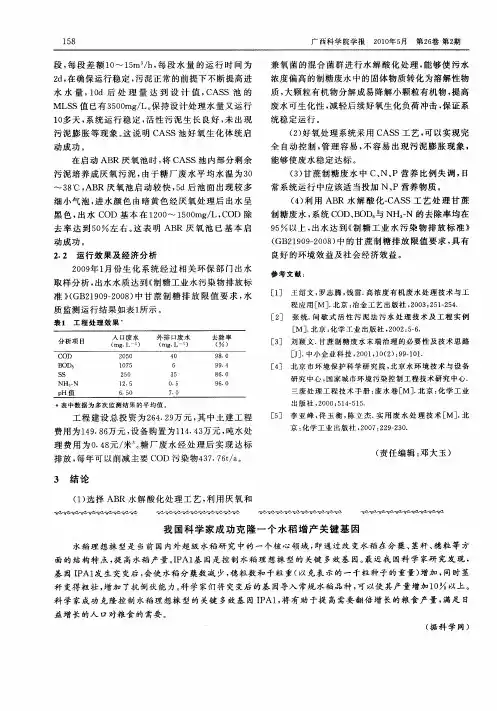
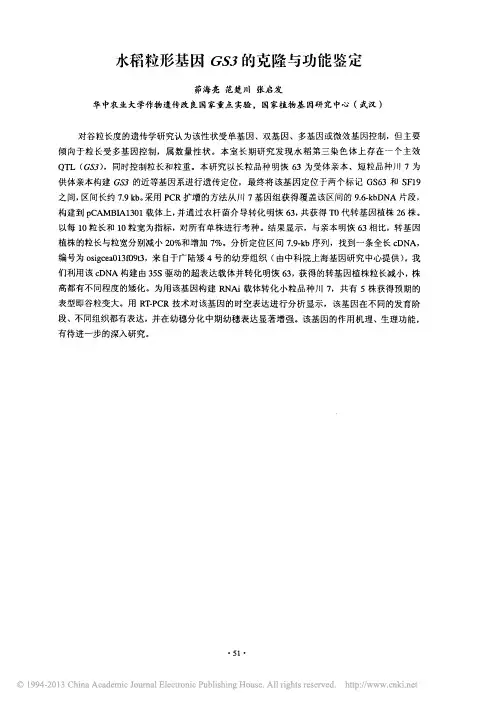
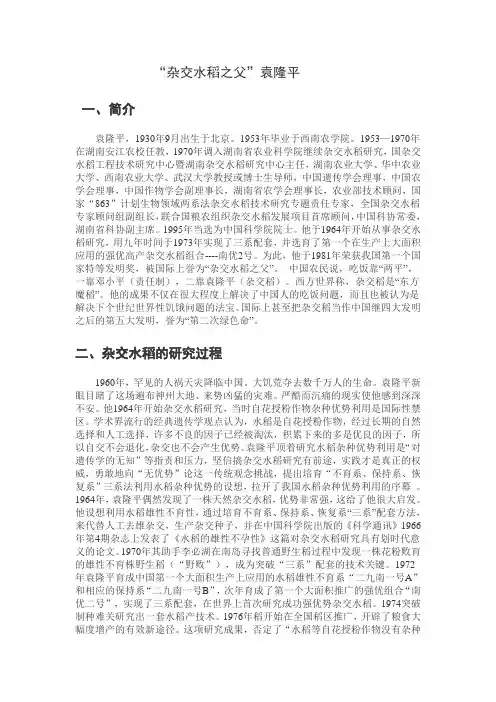
“杂交水稻之父”袁隆平一、简介袁隆平,1930年9月出生于北京。
1953年毕业于西南农学院。
1953—1970年在湖南安江农校任教,1970年调入湖南省农业科学院继续杂交水稻研究,国杂交水稻工程技术研究中心暨湖南杂交水稻研究中心主任,湖南农业大学、华中农业大学、西南农业大学、武汉大学教授或博士生导师,中国遗传学会理事,中国农学会理事,中国作物学会副理事长,湖南省农学会理事长,农业部技术顾问,国家“863”计划生物领域两系法杂交水稻技术研究专题责任专家,全国杂交水稻专家顾问组副组长,联合国粮农组织杂交水稻发展项目首席顾问,中国科协常委,湖南省科协副主席。
1995年当选为中国科学院院士。
他于1964年开始从事杂交水稻研究,用九年时间于1973年实现了三系配套,并选育了第一个在生产上大面积应用的强优高产杂交水稻组合----南优2号。
为此,他于1981年荣获我国第一个国家特等发明奖,被国际上誉为“杂交水稻之父”。
中国农民说,吃饭靠“两平”,一靠邓小平(责任制),二靠袁隆平(杂交稻)。
西方世界称,杂交稻是“东方魔稻”。
他的成果不仅在很大程度上解决了中国人的吃饭问题,而且也被认为是解决下个世纪世界性饥饿问题的法宝。
国际上甚至把杂交稻当作中国继四大发明之后的第五大发明,誉为“第二次绿色命”。
二、杂交水稻的研究过程1960年,罕见的人祸天灾降临中国。
大饥荒夺去数千万人的生命。
袁隆平新眼目睹了这场遍布神州大地、来势凶猛的灾难。
严酷而沉痛的现实使他感到深深不安。
他1964年开始杂交水稻研究,当时自花授粉作物杂种优势利用是国际性禁区。
学术界流行的经典遗传学观点认为,水稻是自花授粉作物,经过长期的自然选择和人工选择,许多不良的因子已经被淘汰,积累下来的多是优良的因子,所以自交不会退化,杂交也不会产生优势。
袁隆平顶着研究水稻杂种优势利用是“对遗传学的无知”等指责和压力,坚信搞杂交水稻研究有前途,实践才是真正的权威,勇敢地向“无优势”论这一传统观念挑战,提出培育“不育系、保持系、恢复系”三系法利用水稻杂种优势的设想,拉开了我国水稻杂种优势利用的序幕。
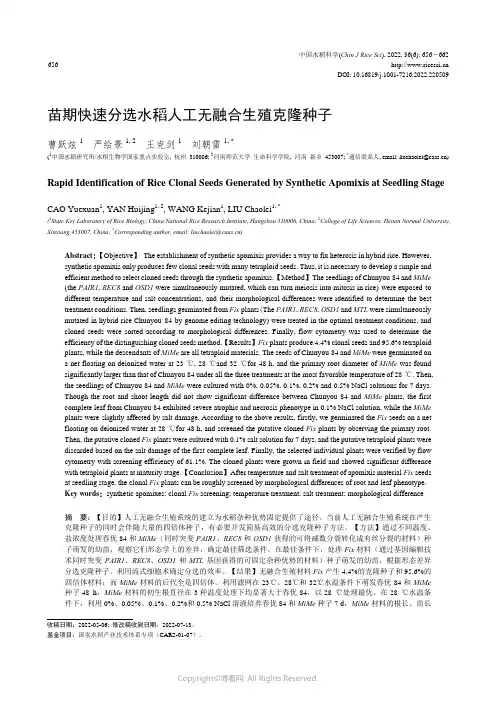
中国水稻科学(Chin J Rice Sci), 2022, 36(6): 656-662 656 DOI: 10.16819/j.1001-7216.2022.220509苗期快速分选水稻人工无融合生殖克隆种子曹跃炫1严绘景1, 2王克剑1刘朝雷1, *(1中国水稻研究所/水稻生物学国家重点实验室, 杭州 310006; 2河南师范大学生命科学学院, 河南新乡 453007; *通信联系人,email:******************) Rapid Identification of Rice Clonal Seeds Generated by Synthetic Apomixis at Seedling StageCAO Yuexuan1, YAN Huijing1, 2, WANG Kejian1, LIU Chaolei1, *(1State Key Laboratory of Rice Biology, China National Rice Research Institute, Hangzhou 310006, China; 2College of Life Sciences, Henan Normal University, Xinxiang 453007, China; *Correspondingauthor,email:******************)Abstract:【Objective】The establishment of synthetic apomixis provides a way to fix heterosis in hybrid rice. However, synthetic apomixis only produces few clonal seeds with many tetraploid seeds. Thus, it is necessary to develop a simple and efficient method to select cloned seeds through the synthetic apomixis.【Method】The seedlings of Chunyou 84 and MiMe (the PAIR1, REC8 and OSD1 were simultaneously mutated, which can turn meiosis into mitosis in rice) were exposed to different temperature and salt concentrations, and their morphological differences were identified to determine the best treatment conditions. Then, seedlings germinated from Fix plants(The PAIR1, REC8, OSD1 and MTL were simultaneously mutated in hybrid rice Chunyou 84 by genome editing technology) were treated in the optimal treatment conditions, and cloned seeds were sorted according to morphological differences. Finally, flow cytometry was used to determine the efficiency of the distinguishing cloned seeds method.【Results】Fix plants produce 4.4% clonal seeds and 95.6% tetraploid plants, while the descendants of MiMe are all tetraploid materials. The seeds of Chunyou84 and MiMe were germinated ona net floating on deionized water at 23 ℃, 28 ℃and 32 ℃for 48 h, and the primary root diameter of MiMe was foundsignificantly larger than that of Chunyou 84 under all the three treatments at the most favorable temperature of 28 ℃. Then, the seedlings of Chunyou 84 and MiMe were cultured with 0%, 0.05%, 0.1%, 0.2% and 0.5% NaCl solutions for 7 days.Though the root and shoot length did not show significant difference between Chunyou 84 and MiMe plants, the first complete leaf from Chunyou 84 exhibited severe atrophic and necrosis phenotype in 0.1% NaCl solution, while the MiMe plants were slightly affected by salt damage. According to the above results, firstly, we germinated the Fix seeds on a net floating on deionized water at 28 ℃for 48 h, and screened the putative cloned Fix plants by observing the primary root.Then, the putative cloned Fix plants were cultured with 0.1% salt solution for 7 days, and the putative tetraploid plants were discarded based on the salt damage of the first complete leaf. Finally, the selected individual plants were verified by flow cytometry with screening efficiency of 61.1%. The cloned plants were grown in field and showed significant difference with tetraploid plants at maturity stage.【Conclusion】After temperature and salt treatment of apomixis material Fix seeds at seedling stage, the clonal Fix plants can be roughly screened by morphological differences of root and leaf phenotype.Key words: synthetic apomixes; clonal Fix screening; temperature treatment; salt treatment; morphological difference摘要:【目的】人工无融合生殖系统的建立为水稻杂种优势固定提供了途径。
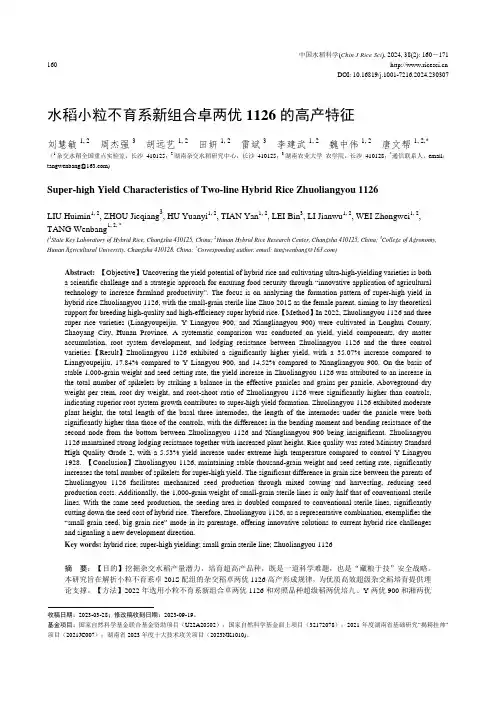
中国水稻科学(Chin J Rice Sci), 2024, 38(2): 160-171 160 DOI: 10.16819/j.1001-7216.2024.230307水稻小粒不育系新组合卓两优1126的高产特征刘慧敏1, 2周杰强3胡远艺1, 2田妍1, 2雷斌3李建武1, 2魏中伟1, 2唐文帮1, 2,*(1杂交水稻全国重点实验室,长沙 410125;2湖南杂交水稻研究中心,长沙 410125;3湖南农业大学农学院,长沙 410128;*通信联系人,email:*******************)Super-high Yield Characteristics of Two-line Hybrid Rice Zhuoliangyou 1126LIU Huimin1, 2, ZHOU Jieqiang3, HU Yuanyi1, 2, TIAN Yan1, 2, LEI Bin3, LI Jianwu1, 2, WEI Zhongwei1, 2, TANG Wenbang1, 2, *(1State Key Laboratory of Hybrid Rice, Changsha 410125, China; 2Hunan Hybrid Rice Research Center, Changsha 410125, China; 3College of Agronomy, Hunan Agricultural University, Changsha 410128, China; *Correspondingauthor,email:*******************)Abstract:【Objective】Uncovering the yield potential of hybrid rice and cultivating ultra-high-yielding varieties is botha scientific challenge and a strategic approach for ensuring food security through “innovative application of agriculturaltechnology to increase farmland productivity”. The focus is on analyzing the formation pattern of super-high yield in hybrid rice Zhuoliangyou 1126, with the small-grain sterile line Zhuo 201S as the female parent, aiming to lay theoretical support for breeding high-quality and high-efficiency super hybrid rice.【Method】In 2022, Zhuoliangyou 1126 and three super rice varieties (Liangyoupeijiu, Y Liangyou 900, and Xiangliangyou 900) were cultivated in Longhui County, Shaoyang City, Hunan Province. A systematic comparison was conducted on yield, yield components, dry matter accumulation, root system development, and lodging resistance between Zhuoliangyou 1126 and the three control varieties.【Result】Zhuoliangyou 1126 exhibited a significantly higher yield, with a 35.07% increase compared to Liangyoupeijiu, 17.84% compared to Y Liangyou 900, and 14.52% compared to Xiangliangyou 900. On the basis of stable 1,000-grain weight and seed setting rate, the yield increase in Zhuoliangyou 1126 was attributed to an increase in the total number of spikelets by striking a balance in the effective panicles and grains per panicle. Aboveground dry weight per stem, root dry weight, and root-shoot ratio of Zhuoliangyou 1126 were significantly higher than controls, indicating superior root system growth contributes to super-high yield formation. Zhuoliangyou 1126 exhibited moderate plant height, the total length of the basal three internodes, the length of the internodes under the panicle were both significantly higher than those of the controls, with the differences in the bending moment and bending resistance of the second node from the bottom between Zhuoliangyou 1126 and Xiangliangyou 900 being insignificant. Zhuoliangyou 1126 maintained strong lodging resistance together with increased plant height. Rice quality was rated Ministry Standard High Quality Grade 2, with a 5.53% yield increase under extreme high temperature compared to control Y Liangyou 1928. 【Conclusion】Zhuoliangyou 1126, maintaining stable thousand-grain weight and seed setting rate, significantly increases the total number of spikelets for super-high yield. The significant difference in grain size between the parents of Zhuoliangyou 1126 facilitates mechanized seed production through mixed sowing and harvesting, reducing seed production costs. Additionally, the 1,000-grain weight of small-grain sterile lines is only half that of conventional sterile lines. With the same seed production, the seeding area is doubled compared to conventional sterile lines, significantly cutting down the seed cost of hybrid rice. Therefore, Zhuoliangyou 1126, as a representative combination, exemplifies the “small grain seed, big grain rice” mode in its parentage, offering innovative solutions to current hybrid rice challenges and signaling a new development direction.Key words: hybrid rice; super-high yielding; small grain sterile line; Zhuoliangyou 1126摘 要:【目的】挖掘杂交水稻产量潜力,培育超高产品种,既是一道科学难题,也是“藏粮于技”安全战略。
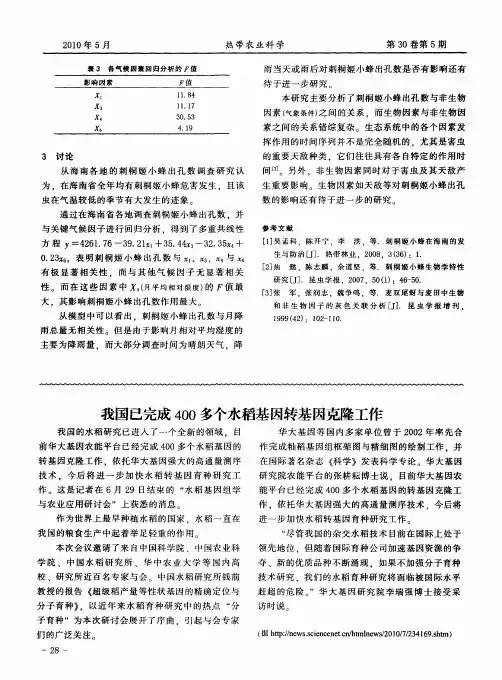
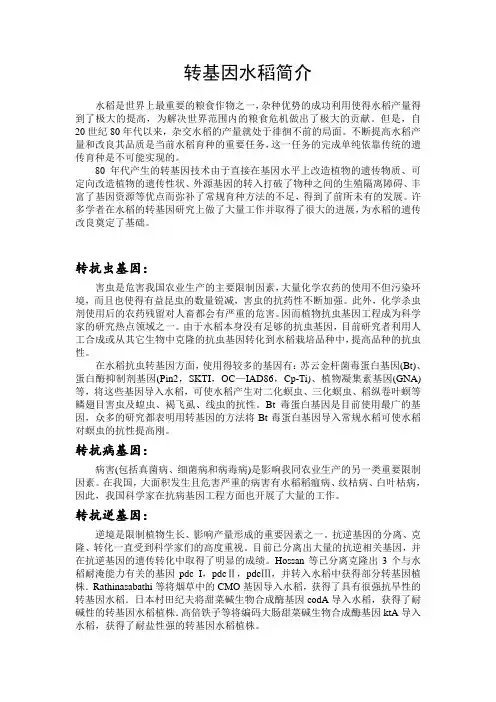
转基因水稻简介水稻是世界上最重要的粮食作物之一,杂种优势的成功利用使得水稻产量得到了极大的提高,为解决世界范围内的粮食危机做出了极大的贡献。
但是,自20世纪80年代以来,杂交水稻的产量就处于徘徊不前的局面。
不断提高水稻产量和改良其品质是当前水稻育种的重要任务,这一任务的完成单纯依靠传统的遗传育种是不可能实现的。
80年代产生的转基因技术由于直接在基因水平上改造植物的遗传物质、可定向改造植物的遗传性状、外源基因的转入打破了物种之间的生殖隔离障碍、丰富了基因资源等优点而弥补了常规育种方法的不足,得到了前所未有的发展。
许多学者在水稻的转基因研究上做了大量工作并取得了很大的进展,为水稻的遗传改良奠定了基础。
转抗虫基因:害虫是危害我国农业生产的主要限制因素,大量化学农药的使用不但污染环境,而且也使得有益昆虫的数量锐减,害虫的抗药性不断加强。
此外,化学杀虫剂使用后的农药残留对人畜都会有严重的危害。
因而植物抗虫基因工程成为科学家的研究热点领域之一。
由于水稻本身没有足够的抗虫基因,目前研究者利用人工合成或从其它生物中克隆的抗虫基因转化到水稻栽培品种中,提高品种的抗虫性。
在水稻抗虫转基因方面,使用得较多的基因有:苏云金杆菌毒蛋白基因(Bt)、蛋白酶抑制剂基因(Pin2,SKTI,OC—IAD86,Cp-Ti)、植物凝集素基因(GNA)等,将这些基因导入水稻,可使水稻产生对二化螟虫、三化螟虫、稻纵卷叶螟等鳞翅目害虫及蝗虫、褐飞虱、线虫的抗性。
Bt毒蛋白基因是目前使用最广的基因,众多的研究都表明用转基因的方法将Bt毒蛋白基因导入常规水稻可使水稻对螟虫的抗性提高刚。
转抗病基因:病害(包括真菌病、细菌病和病毒病)是影响我同农业生产的另一类重要限制因素。
在我国,大面积发生且危害严重的病害有水稻稻瘟病、纹枯病、白叶枯病,因此,我国科学家在抗病基因工程方面也开展了大量的工作。
转抗逆基因:逆境是限制植物生长、影响产量形成的重要因素之一。
基因组学与应用生物学,2020年,第39卷,第9期,第4073-4081页研究报告Research Report两种不同化感潜力水稻CYP73A38基因及其启动子的克隆分析杨奕*孙一丁*马继琼许明辉**云南省农业科学院生物技术与种质资源研究所,云南省农业生物技术重点实验室,农业部西南作物基因资源与种质创制重点实验室,昆明, 650223*同等贡献作者**通信作者,*****************摘要水稻化感作用指水稻通过向环境中释放次生代谢产物来影响周围植物的生长。
本研究以国际公认的化感水稻PI312777和非化感水稻Lemont为材料,克隆肉桂酸-4-羟化酶(C4H)编码基因CYP73A38的cDNA序列进行对比分析,发现两种水稻在该基因的序列差异极小,存在6个位点差异。
为了进一步揭示两种水稻化感潜力不同的原因,对CYP73A38启动子进行了克隆分析,获得CYP73A38基因启动子序列,该启动子序列包含CAAT-box、TATA-box、光响应元件、赤霉素响应元件、生长素响应元件、低温响应元件等多个顺式作用元件及MYB类转录因子结合位点,且差异位点均不在顺式作用元件上,由此推测两种水稻化感潜力的差异与基因结构没有相关性。
不同化感潜力水稻CYP73A38基因及其启动子的克隆与序列分析,将为进一步研究CYP73A38基因的表达调控及其启动子功能分析提供参考,为加快水稻化感抗性品种的选育进程提供依据。
关键词化感水稻,CYP73A38,启动子Cloning Analysis of CYP73A38Gene and Its Promoter in Two Different Allelopathic Potential of RiceYang Yi*Sun Yiding*Ma Jiqiong Xu Minghui**The Key Laboratory of Biotechnology Research of Yunnan Province,Key Lab of Southwestern Crop Gene Resources and Germplasm Innovation of Ministry of Agriculture,Institute of Biotechnology and Genetic Resources,YAAS,Kunming,650223*The authors contributed equally to this work**Corresponding author,*****************DOI:10.13417/j.gab.039.004073Abstract Rice alle lopathy is mainly responsible for the growth of around plant by releasing secondary metabolites into the environment.In this study,allelopathic rice PI312777and non-allelopathic rice Lemont were used as materials,cloned the cinnamic acid-4-hydroxylase(C4H)coding gene CYP73A38full length of sequence cDNA and comparatived difference.The differences in the sequence of this gene in allelopathic and non-allelic rice were slight.A total of6nucleotide variations were found in the ORFs.In order to research the reason of two rice with different allelopathic potential,the study cloned the promoter sequence of CYP73A38.The promoter sequence contained multiple cis-acting elements,such as CAAT-box,TATA-box,light responsive element,gibberellins responsive element,auxin responsive element,low-temperature responsive element,MYB recognition site,and others.And all variation sites are not in the cis-acting elements.Thus speculate that the differences of two allelopathy potential rice do es not correlate with the genetic structure.Cloning and characterization of the基金项目:本研究由云南省科技计划青年项目(2017FD204)资助引用格式:Yang Y.,Sun Y.D.,Ma J.Q.,and Xu M.H.,2020,Cloning analysis of CYP73A38gene and its promoter in two different allelopathic potential of rice,Jiyinzuxue Yu Yingyong Shengwuxue(Genomics and Applied Biology),39(9):4073-4081(杨奕,孙一丁,马继琼,许明辉,2020,两种不同化感潜力水稻CYP73A38基因及其启动子的克隆分析,基因组学与应用生物学,39(9): 4073-4081)基因组学与应用生物学水稻是全世界最主要的粮食作物之一,据联合国粮农组织(FAO)调查,每年因病虫草害等生物因素造成的粮食损失约占全球粮食总产量的1/3,其中草害导致的农作物产量损失约为11%。